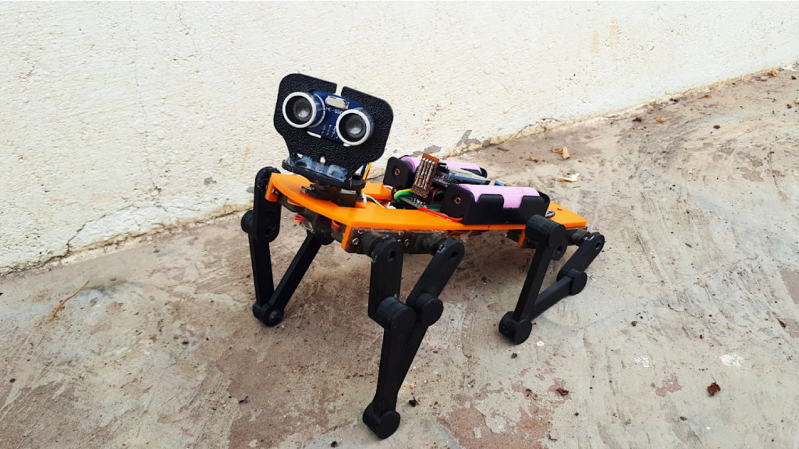3D printers have become a staple in most makerspaces these days, enabling hackers to rapidly produce simple mechanical prototypes without the need for a dedicated machine shop. We’ve seen many creative 3D designs here on Hackaday and [jegatheesan.soundarapandian’s] Baby MIT Cheetah Robot is no exception. You’ve undoubtedly seen MIT’s cheetah robot. Well, [jegatheesan’s] hack takes a personal spin on the cheetah robot and his results are pretty cool.
The body of the robot is 3D printed making it easy to customize the design and replace broken parts as you go. The legs are designed in a five-bar linkage with two servo motors controlling each of the four legs. An additional servo motor is used to rotate an HC-SR04, a popular ultrasonic distance sensor, used in the autonomous mode’s obstacle avoidance mechanism. The robot can also be controlled over Bluetooth using an app [jegatheesan] developed in MIT App Inventor.
Overall, the mechanics could use a bit of work — [jegatheesan’s] baby cheetah probably won’t outpace MIT’s robot any time soon — but it’s a cool hack and we’re looking forward to a version 3. Maybe the cheetah would make a cool companion bot?

















Neato, could provoke some Xmas models, great for stem teaching too, thanks for post :-)
Cheers
cute lil guy that one!! the magic of encoders + dc motors and a bit of plastic engineerin!
Seems like it could use a little more mass for higher friction at the feet floor interface (looks like the motors can take it). Probably a bit more work needed on the gait too, though being so simple its never going to be as fluid and stable as something with more complexity (making it a 6 leg would help there a great deal).
But damn neat, simple mechanical design so should be reasonably cheap to make.. Being so visible in how it works and ‘cute’ I can imagine fascinating younger children as it moves around and its a good simple example Programming engineering test bed you can just let them learn on. Certainly wouldn’t want to let a novice try to program or re-engineer your more expensive robots where each joint’s motor probably cost as much as this whole thing..
I’d say that what could help a lot is to have something that balances the robot while it walks. Clearly from the movie, you can see that the left side is slightly heavier than the right side.
But also, the gait is not stable. While walking, it has to balance on two legs for every step (and it falls over all the time). There is a reason that no animal walks like that. :P All animals, when they have 4 legs, and don’t walk upright, will keep 3 legs on the floor at one time, with possibly a ‘hovering’ moment where it might have 2 legs on the floor (or even 0 legs on the floor). But hovering makes walking much harder, because you need to time perfectly.
I would guess that adding something that can change the weight distribution dynamically and keep balance while having 2 feet on the floor, would help tremendously. A tail, or something that acts like a tail.
I was also thinking about a flywheel, acting as a single-plane gyroscope. But imagine what would happen with all that stored energy if the robot tripped. :D :D
When I see “walking” robots I immediately wonder when (and why not already) some smart software developers come around the corner with a neural network that makes such a robot move natural.
There has been such things – one team made a robot that learned to walk and could then learn to walk again after deliberate damage. Can’t recall who or where off the top of my head, but it has been done. In this case the mechanical simplicity means with only 4 legs and no way to shift centre of mass relative to the feet it will never look fluid and graceful on the move. Perhaps with a massive flywheel to help keep the body level as it steps you could get into gaits that give smooth motion.
Not sure if a flywheel would be so safe. So much stored energy in such a small place could end up in disaster. ;)